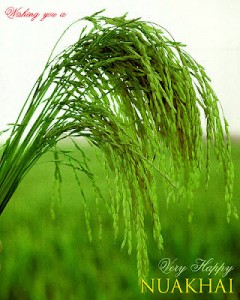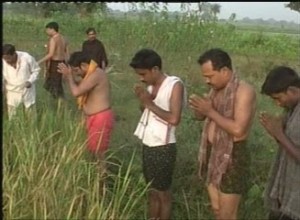 For the year 2016 Nuakhai would be celebrated on 6th September the Tuesday. And 7th September would be Basi.
For the year 2016 Nuakhai would be celebrated on 6th September the Tuesday. And 7th September would be Basi.
India has got one of the oldest human civilization on earth. We got the most vibrant cultural heritage, which is diverse from region to region. Every state of it has got a different living style as compared to its neighbor, either on the basis of the clothes that we wear or the food that we eat. But somewhere there lays the unity in its diversity. We the Indians pay rich reverence to the food that we eat. Welcoming the harvest of the new paddy (rice) crop is celebrated as Onam in Kerala, in Andhra Pradesh they call it Pongal, in Assam it is Bihu. Likewise in Western Odisha we celebrate Nuakhai or Nabarna.
Nuakhai is the prominent out of all those festivals that are being celebrated in Koshal region comprising the districts of Sambalpur, Bargarh, Balangir, Sonepur, Jharsuguda, Sundargarh, Kalahandi and Nuapada of Odisha. The fundamental idea of the celebration can be traced back at least to the Vedic times when the rishis (sages) had talked of panchayajna. These are the five important activities in the annual calendar of an agrarian society. These five activities have been specified as Sita Yajna (the tilling of the land), Pravapana Yajna (the sowing of seeds), Pralambana Yajna (the initial cutting of crops), Khala Yajna (the harvesting of grains) and Prayayana Yajna (the preservation of the seeds). In view of this, Nuakhai may be seen as having evolved out of the third activity, namely Pralambana Yajna, which involves cutting the first crop. The essence of this festival is to express man’s gratitude to nature. While in other parts of the country, festivals are celebrated only after the harvest of the crop, but in Koshal region Nuakhai is observed much before the harvest of the crop, as Koshalis would like to worship the deities before the seeds are consumed by any creature on earth, let it be human beings, beasts or the bird.
Nuakhai is observed on the Panchami Tithi (fifth day) of the lunar fortnight of Bhadraba month of Hindu calendar year. In simple language it is the day following Ganesh Chaturthy, which generally falls either in the month of August or September of each year. There is no recorded history about its origin, but there is official reference of its celebration on the records of princely state of Balangir. Though it is a festival of the farmers, but gradually adopted by one and all of the society.
 An auspicious moment is set on this day called Muhurt or Lagna to perform the puja. “Nua” is prepared by extracting the new rice (in the raw state) from paddy and is mixed with milk, nadia-kura (coconut), rasi (til) and honey. Depending upon as many family members each home got, Nua is equally distributed and placed in that much number of Kurei leaf danas (handmade leaf-bowls), and offered for puja. In each home the women folk do the puja to their family istha-devata. When the puja is over, each family member holds his dana with the left-hand while lifting the Nua with all the five fingers of his right-hand to eat. This rule of using the five fingers is strictly observed, so that the person who eats Nua with five-fingers will have a wholesome and fulfilled life. On the day of Nuakhai farmers goes to the khet-khala or firm land to offer puja to the crops. They tie sacred thread or rakhi to the rice plants, while offering milk to the cultivated land. At the same time cows and bullocks are as well offered puja by tying rakhis on their horns and given jaggery or gud (in Oriya) to eat.
An auspicious moment is set on this day called Muhurt or Lagna to perform the puja. “Nua” is prepared by extracting the new rice (in the raw state) from paddy and is mixed with milk, nadia-kura (coconut), rasi (til) and honey. Depending upon as many family members each home got, Nua is equally distributed and placed in that much number of Kurei leaf danas (handmade leaf-bowls), and offered for puja. In each home the women folk do the puja to their family istha-devata. When the puja is over, each family member holds his dana with the left-hand while lifting the Nua with all the five fingers of his right-hand to eat. This rule of using the five fingers is strictly observed, so that the person who eats Nua with five-fingers will have a wholesome and fulfilled life. On the day of Nuakhai farmers goes to the khet-khala or firm land to offer puja to the crops. They tie sacred thread or rakhi to the rice plants, while offering milk to the cultivated land. At the same time cows and bullocks are as well offered puja by tying rakhis on their horns and given jaggery or gud (in Oriya) to eat.
When the puja is over, all the members of the family seat together to have Nuakhai feast. On this day special sweet dishes are being prepared in each home like Bubra, Kakra, Arisha, Feni, Mandapitha and Khiri.
Afterwards the youngers pay their unfathomable regards to the elders with Nuakhai Juhar by folding their both hands, while leaning down their heads. On the other end the women folk do mundia to the elders by leaning down their body with the support of knee while touching their head on the ground. I suggest you to do Nuakhai Juhar to one and all the elders, known or un-known on the street to get the blessings both in kind and in cash.
While the day hours of Nuakhai are pre-occupied with the family celebration, the evening hours are contributed for social celebrations called Nuakhai Bhetghat. At this hour cultural programms are conducted at the city centers by organizing Ghumra, Sambalpuri folk-dance or kabi-sanmelani. While in the villages people gather at the corner of the street to listen the Bhagabat charcha.
The day following Nuakhai is called Basi. In Oriya Basi means old. While the Nuakhai is a day to observe satwik food, Basi is observed to have tamasic food or non-vegetarians. This day is celebrated with much fanfare. On the day of Basi neither you will find a porter at the railway station nor at bus stand, no rikshaws or taxis on the road. All the shops and establishments are closed. Life stands dead still. Finally a word of caution from the author of this article. If you happens to be in Koshal region on this day, I alert you not to venture-out of your home or hotel let wherever you are, as each and every street is deserted. If you comes out, you are most likely to encounter with the drunkards on the street.
 It is the time to rejoice for one and all of a family. Let it be the children, parents or grand-parents. The kith and kin of each family returns home, let which corner of the earth they reside. Even if two brothers are separated, forgiving their animosity they re-unite on this day at their ancestral house to celebrate Nuakhai. While the elderly rejoice to see the children and grand-children at home, the growing-up go for shopping for the new dress-materials and the children enjoy buying pan, puduia and chocolates with the Nuakhai bakshis (tips) they get from the elders.
It is the time to rejoice for one and all of a family. Let it be the children, parents or grand-parents. The kith and kin of each family returns home, let which corner of the earth they reside. Even if two brothers are separated, forgiving their animosity they re-unite on this day at their ancestral house to celebrate Nuakhai. While the elderly rejoice to see the children and grand-children at home, the growing-up go for shopping for the new dress-materials and the children enjoy buying pan, puduia and chocolates with the Nuakhai bakshis (tips) they get from the elders.
Shri Bailochan Dash a gahantia (landlord) of Ludkibeda village (Dist. Sonepur) shares about an ancient tradition of his region called “Nuakhai Khanja” which is being kept alive till date in this corner of the earth. In a Nuakhai Khanja or Adhia Bhar people sends rice, dal and vegetables to their mita-marsad (friends) to prepare the Nuakhai feast, who on the other end sends back the pitha n’ panna. This is how we the Koshali habitants pay rich tribute to the food that we eat, which in return strengthens our family and social bonds.
reference: http://barpalidays.blogspot.in/2011/08/nuakhai.html
